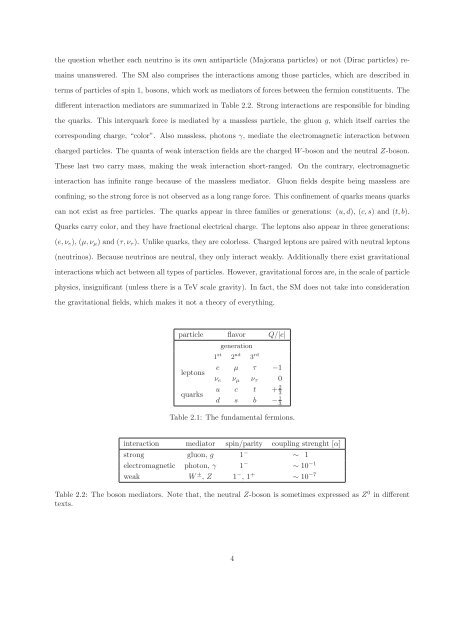CERN-THESIS-2012-153 26/07/2012 - CERN Document Server
CERN-THESIS-2012-153 26/07/2012 - CERN Document Server
CERN-THESIS-2012-153 26/07/2012 - CERN Document Server
You also want an ePaper? Increase the reach of your titles
YUMPU automatically turns print PDFs into web optimized ePapers that Google loves.
the question whether each neutrino is its own antiparticle (Majorana particles) or not (Dirac particles) re-<br />
mains unanswered. The SM also comprises the interactions among those particles, which are described in<br />
terms of particles of spin 1, bosons, which work as mediators of forces between the fermion constituents. The<br />
different interaction mediators are summarized in Table 2.2. Strong interactions are responsible for binding<br />
the quarks. This interquark force is mediated by a massless particle, the gluon g, which itself carries the<br />
corresponding charge, “color”. Also massless, photons γ, mediate the electromagnetic interaction between<br />
charged particles. The quanta of weak interaction fields are the charged W-boson and the neutral Z-boson.<br />
These last two carry mass, making the weak interaction short-ranged. On the contrary, electromagnetic<br />
interaction has infinite range because of the massless mediator. Gluon fields despite being massless are<br />
confining, so the strong force is not observed as a long range force. This confinement of quarks means quarks<br />
can not exist as free particles. The quarks appear in three families or generations: (u,d), (c,s) and (t,b).<br />
Quarks carry color, and they have fractional electrical charge. The leptons also appear in three generations:<br />
(e,νe), (µ,νµ) and (τ,ντ). Unlike quarks, they are colorless. Charged leptons are paired with neutral leptons<br />
(neutrinos). Because neutrinos are neutral, they only interact weakly. Additionally there exist gravitational<br />
interactions which act between all types of particles. However, gravitational forces are, in the scale of particle<br />
physics, insignificant (unless there is a TeV scale gravity). In fact, the SM does not take into consideration<br />
the gravitational fields, which makes it not a theory of everything.<br />
particle flavor Q/|e|<br />
leptons<br />
quarks<br />
1 st<br />
generation<br />
2 nd<br />
3 rd<br />
e µ τ −1<br />
νe νµ ντ 0<br />
u c t + 2<br />
3<br />
d s b − 1<br />
3<br />
Table 2.1: The fundamental fermions.<br />
interaction mediator spin/parity coupling strenght [α]<br />
strong gluon, g 1 − ∼ 1<br />
electromagnetic photon, γ 1 − ∼ 10 −1<br />
weak W ± , Z 1 − , 1 + ∼ 10 −7<br />
Table 2.2: The boson mediators. Note that, the neutral Z-boson is sometimes expressed as Z 0 in different<br />
texts.<br />
4















